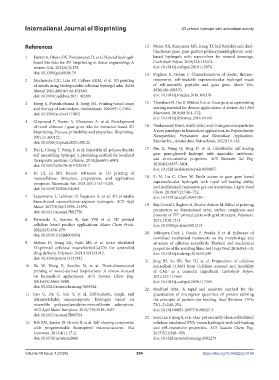Page 262 - IJB-10-1
P. 262
International Journal of Bioprinting 3D-printed hydrogel with antioxidant activity
References 13. Palem RR, Kummara MR, Kang TJ. Self-healable and dual-
functional guar gum-grafted-polyacrylamidoglycolic acid-
1. Fatimi A, Okoro OV, Podstawczyk D, et al. Natural hydrogel- based hydrogels with nano-silver for wound dressings.
based bio-inks for 3D bioprinting in tissue engineering: A Carbohydr Polym. 2019;223:115074.
review. Gels. 2022;8(3):179. doi: 10.1016/j.carbpol.2019.115074
doi: 10.3390/gels8030179 14. Pugliese R, Gelain F. Characterization of elastic, thermo-
2. Nocheseda CJC, Liza FP, Collera AKM, et al. 3D printing responsive, self-healable supramolecular hydrogel made
of metals using biodegradable cellulose hydrogel inks. Addit of self-assembly peptides and guar gum. Mater Des.
Manuf. 2021;48(Part A):102380. 2020;186:108370.
doi: 10.1016/j.addma.2021.102380 doi: 10.1016/j.matdes.2019.108370
3. Hong S, Purushothama B, Song JM. Printing-based assay 15. Thombare N, Jha U, Mishra S, et al. Guar gum as a promising
and therapy of antioxidans. Antioxidants. 2020;9(11):1052. starting material for diverse applications: A review. Int J Biol
doi: 10.3390/antiox9111052 Macromol. 2016;88:361–372.
doi: 10.1016/j.ijbiomac.2016.04.001
4. Cleymand F, Poerio A, Mamanov A, et al. Development
of novel chitosan / guar gum inks for extrusion-based 3D 16. Venkatesan J, Kim S, Anil S, (eds.), et al. Guar gum nanoparticles:
bioprinting: Process, printability and properties. Bioprinting. A new paradigm in biomedical applications, in Polysaccharide
2021;21:e00122. Nanoparticles: Preparation and Biomedical Applications,
doi: 10.1016/j.bprint.2020.e00122 Elsevier Inc., Amsterdam, Netherlands. 2022;119–143.
5. Dai L, Cheng T, Wang Y, et al. Injectable all-polysaccharide 17. Pan X, Wang Q, Ning D, et al. Ultraflexible self-healing
self-assembling hydrogel: a promising scaffold for localized guar gum-glycerol hydrogel with injectable, antifreeze,
therapeutic proteins. Cellulose. 2019;26:6891–6901. and strain-sensitive properties. ACS Biomater Sci Eng.
doi: 10.1007/s10570-019-02579-7 2018;4(9):3397−3404.
doi: 10.1021/acsbiomaterials.8b00657
6. Ee LY, Li SFY. Recent advances in 3D printing of
nanocellulose: Structure, preparation, and application 18. Li N, Liu C, Chen W. Facile access to guar gum based
prospects. Nanoscale Adv. 2021;3(5):1167–1208. supramolecular hydrogels with rapid self-healing ability
doi: 10.1039/D0NA00408A and multistimuli responsive gel−sol transitions. J Agric Food
Chem. 2019;67(2):746−752.
7. Leppiniemi J, Lahtinen P, Paajanen A, et al. 3D-printable doi: 10.1021/acs.jafc.8b05130
bioactivated nanocellulose–alginate hydrogels. ACS Appl
Mater. 2017;9(26):21959–21970. 19. Buj-Corral I, Bagheri A, Sivatte-Adroer M. Effect of printing
doi: 10.1021/acsami.7b02756 parameters on dimensional error, surface roughness and
porosity of FFF printed parts with grid structure. Polymers.
8. Firmanda A, Syamsu K, Sari YW, et al. 3D printed 2021;13(8):1213.
cellulose based product applications. Mater Chem Front. doi: 10.3390/polym13081213
2022;6(3):254–279.
doi: 10.1039/D1QM00390A 20. Velásquez-Cock J, Ganán P, Posada P, et al. Influence of
combined mechanical treatments on the morphology and
9. Mohan D, Teong ZK, Sajab MS, et al. Intact fibrillated structure of cellulose nanofibrils: Thermal and mechanical
3D-printed cellulose macrofibrils/CaCO3 for controlled properties of the resulting films. Ind Crops Prod. 2016;85:1–10.
drug delivery. Polymers. 2021;13(12):1912. doi: 10.1016/j.indcrop.2016.02.036
doi: 10.3390/polym13121912
21. Jang JH, So BR, Yeo HJ, et al. Preparation of cellulose
10. Xu W, Wang X, Sandler N, et al. Three-dimensional microfibril (CMF) from Gelidium amansii and feasibility
printing of wood-derived biopolymers: A review focused of CMF as a cosmetic ingredient. Carbohydr Polym.
on biomedical applications. ACS Sustain Chem Eng. 2021;257:117569.
2018;6(5):5663–5680. doi: 10.1016/j.carbpol.2020.117569
doi: 10.1021/acssuschemeng.7b03924
22. Bradford MM. A rapid and sensitive method for the
11. Gao G, Du G, Sun Y, et al. Self-healable, tough, and quantitation of microgram quantities of protein utilizing
ultrastretchable nanocomposite hydrogels based on the principle of protein-dye binding. Anal Biochem. 1976;
reversible polyacrylamide/montmorillonite adsorption. 72(1-2):248–254.
ACS Appl Mater Interfaces. 2015;7(8):5029–5037. doi: 10.1016/0003-2697(76)90527-3
doi: 10.1021/acsami.5b00704
23. Lu B, Lin F, Jiang X, et al. One-pot assembly of microfibrillated
12. Erb RM, Sander JS, Grisch R, et al. Self-shaping composites cellulose reinforced PVA−borax hydrogels with self-healing
with programmable bioinspired microstructures. Nat and pH-responsive properties. ACS Sustain Chem Eng.
Commun. 2013;4(1):1712. 2017;5(1):948−956.
doi: 10.1038/ncomms2666 doi: 10.1021/acssuschemeng.6b02279
Volume 10 Issue 1 (2024) 254 https://doi.org/10.36922/ijb.0164

